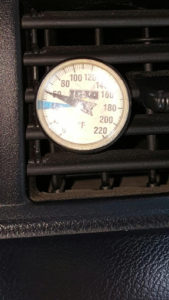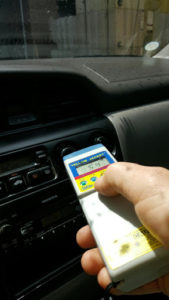On a hot day, if you can get a center A/C vent to register at 20 degrees below ambient, you’re doing fine, and the system is functioning about as well as you can expect.


Use an analog or infrared digital thermometer to check air temp on center vent. It’s 85 degrees today. I’m doing OK!
A quick way to determine if you have trapped refrigerant in the accumulator or dryer is to (this happens especially on cooler days, or when the vehicle is cool) look for a frost line on the accumulator or dryer tank. If you see one you can:
- a) warm up the vehicle
- b) get out a heat gun and melt the oil that’s trapping the refrigerant in the tank
- c) give up and move on to the next vehicle
This occurs during the recovery stage of an A/C Service, and can sometimes lead to an inaccurate charge.
If your line in and line out of the accumulator feel like they are the same temperature (they should both be cold) you have a functioning A/C system.
The general rule of thumb, for compressor oil replacement, is to replace the same amount that you pulled out during refrigerant recovery. Typically, there is no sight gauge or dipstick on the compressor, and the only way to be absolutely certain that you’re providing a factory fill is to remove the compressor, empty it of oil, and refill it per factory spec. We all know that no one is going to do that-put in what you get out. It is my personal belief (based on 30 years of experience) that if you get anything out, the system is overfilled, but be safe.
When purchasing a Refrigerant Management System, choose a system that will do a full service-Recover, Recycle, Deep Vacuum, and Recharge in an unattended fashion. That is, you enter the parameters-charge amount, vacuum time, vacuum hold time, etc- and the machine will perform the full service automatically (Like the Yellow Jacket 37880 and 37887), and notify you with an audible tone as to when it has completed the full service. You also want a machine that allows for each of the major steps-recover, recharge, deep vacuum, etc-independently. This allows for effective diagnosis of system problems. For example, if you cannot get the compressor to cycle, try charging the system with a pound of refrigerant. It may be under-filled, and the pressure switch is preventing cycling. Then recover everything and give it a factory charge.
There are still a few “Multi-Pass recycling” refrigerant management systems out there. Avoid these machines at all costs. Multi-pass means that the recovered refrigerant must pass through the filter(s) more than one time to reach the required purity. These machines are slow and they wear out prematurely.
Any new system that is purchased (This dates back to 2008) must meet SAE Standard J2788. There are three components to this SAE standard:
1) 95% of refrigerant in a mobile system must be recovered in 30 minutes or less. The
Yellow Jacket units accomplishes this with dual compressors, and also by injecting hot refrigerant back into the vehicle, which raises the system pressure and speeds recovery.
2) The system must possess inherent charging accuracy of plus/minus 1/2 ounce.
The Yellow Jacket units achieve this by feathering the charging solenoid over the
last fraction of an ounce during the charge. This method delivers an extremely
accurate charge.
3) The unit must possess a mandatory filter lockout function. The car makers, and the
EPA don’t want you charging a vehicle’s system with dirty refrigerant. Therefore,
when the machine filter(s) is shot, the machine disables itself until you replace the
the filter. On the Yellow jacket units, this occurs at 150 lbs of refrigerant
recovered. It’s a great idea to have an extra filter on hand, so you don’t get locked
out in the middle of a service.
If you buy a system that doesn’t meet SAE J2788, you’re wasting your money.
It’s an excellent idea to choose a machine with a refrigerant management function. This function typically indicates the amount of refrigerant the machine has recovered over it’s lifetime, the amount it has charged, total operating time, number of jobs performed, etc. If you ever get audited by the EPA (chances of this happening are slim, but increasing as this agency looks for more revenue) you have all relevant information at your fingertips. This useful function is integral to all of the Yellow Jacket machines sold here.